Danish Rye Bread (Rugbrød) is dense, hearty, and packed with rye flour, whole grains, and a variety of nutritious seeds. A true staple of Nordic cuisine, this richly flavored, slightly tangy bread is the foundation of smørrebrød (Danish open-faced sandwiches) and a key part of the Scandinavian diet.
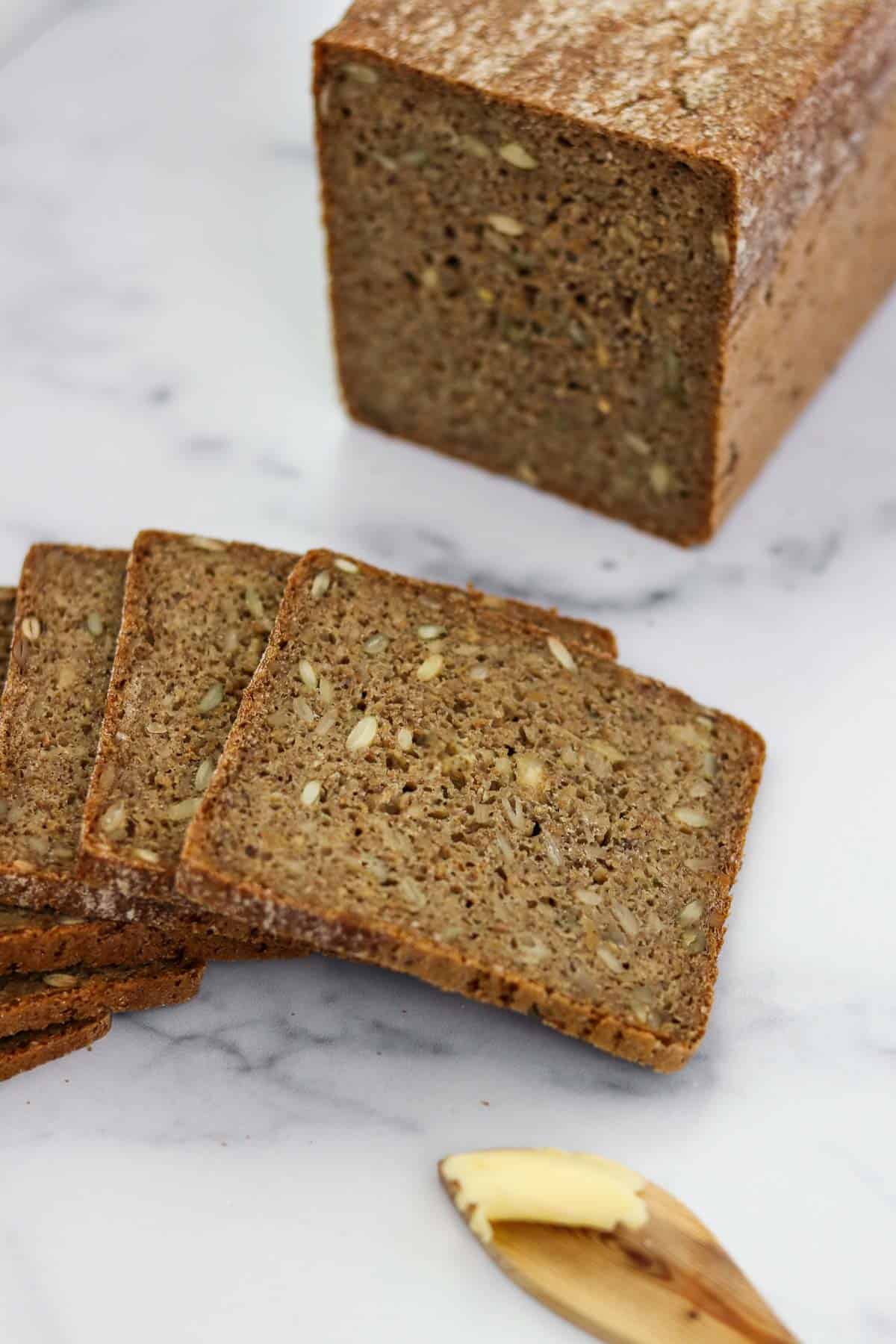
If you’ve ever tried to find authentic rugbrød in the U.S., you know it can be a challenge. Most store-bought rye bread here is closer to deli rye or pumpernickel, lacking the depth and texture of traditional Danish rye. But the good news? You can make it at home—easily!
If you keep a sourdough starter around, you might also want to consider trying my recipe for Sourdough Danish Rye Bread (Rugbrød) which is also really delicious!
Jump to:
Ingredients
For the Soaker:
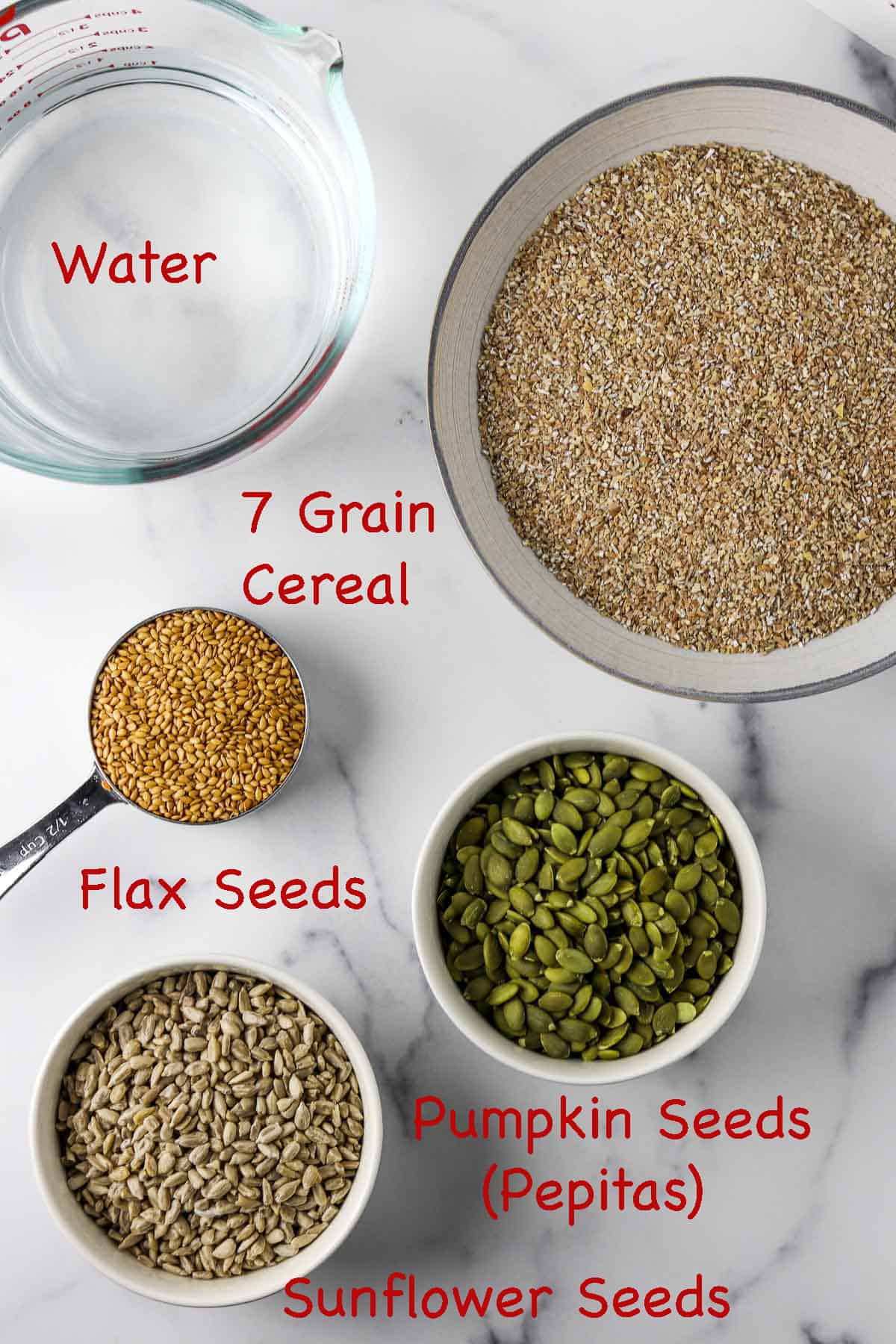
- 7 grain cereal - provides the hearty backdrop of the bread. Traditional rugbrød recipes call for rye chops which are just coarsely chopped pieces of rye grains. Because rye chops can be hard to find in the U.S., this recipe calls for a 7 grain cereal mix instead (feel free to use rye chops if you have access to them! They work just as well here). 7 grain cereal mix is simply a combination of several different coarsely chopped grains including wheat, rye, triticale, oats, oat bran, barley and/or brown rice. I often use the Bob's Red Mill brand, but have also had good luck with this mix from Nuts.com.
- Sunflower, pumpkin and flax seeds - bring texture, flavor and nutrients to this hearty, substantial loaf.
For the Dough:
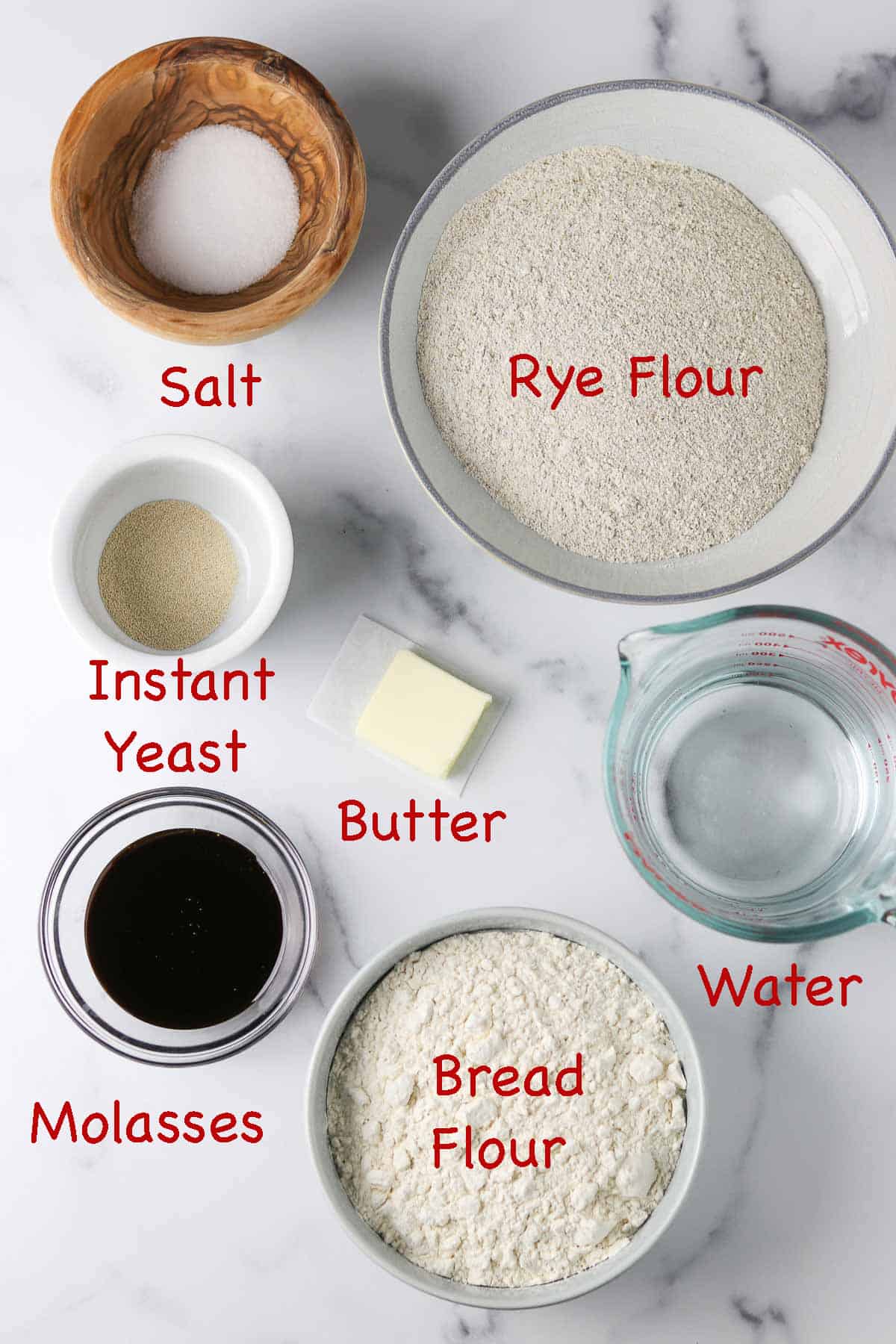
- A combination of bread flour and rye flour - is key to providing the gluten structure this bread needs to keep its shape.
- Instant yeast - serves as the leavener. Please note that instant or rapid rise yeast and active dry yeast are two different things. The essential difference between the two is that instant yeast can be mixed right in with the dry ingredients whereas active dry yeast is designed to be proofed in warm liquid prior to adding it to the recipe. Instant yeast is also more reliable, effective and fast-acting.
- Molasses - not only sweetens and flavors the dough, it also helps deepen the dark brown color of the final loaf.
- Water
- Salt
- Butter - for greasing the pan.
The Equipment
How To Make Danish Rye Bread (Rugbrød)
The Night Before:
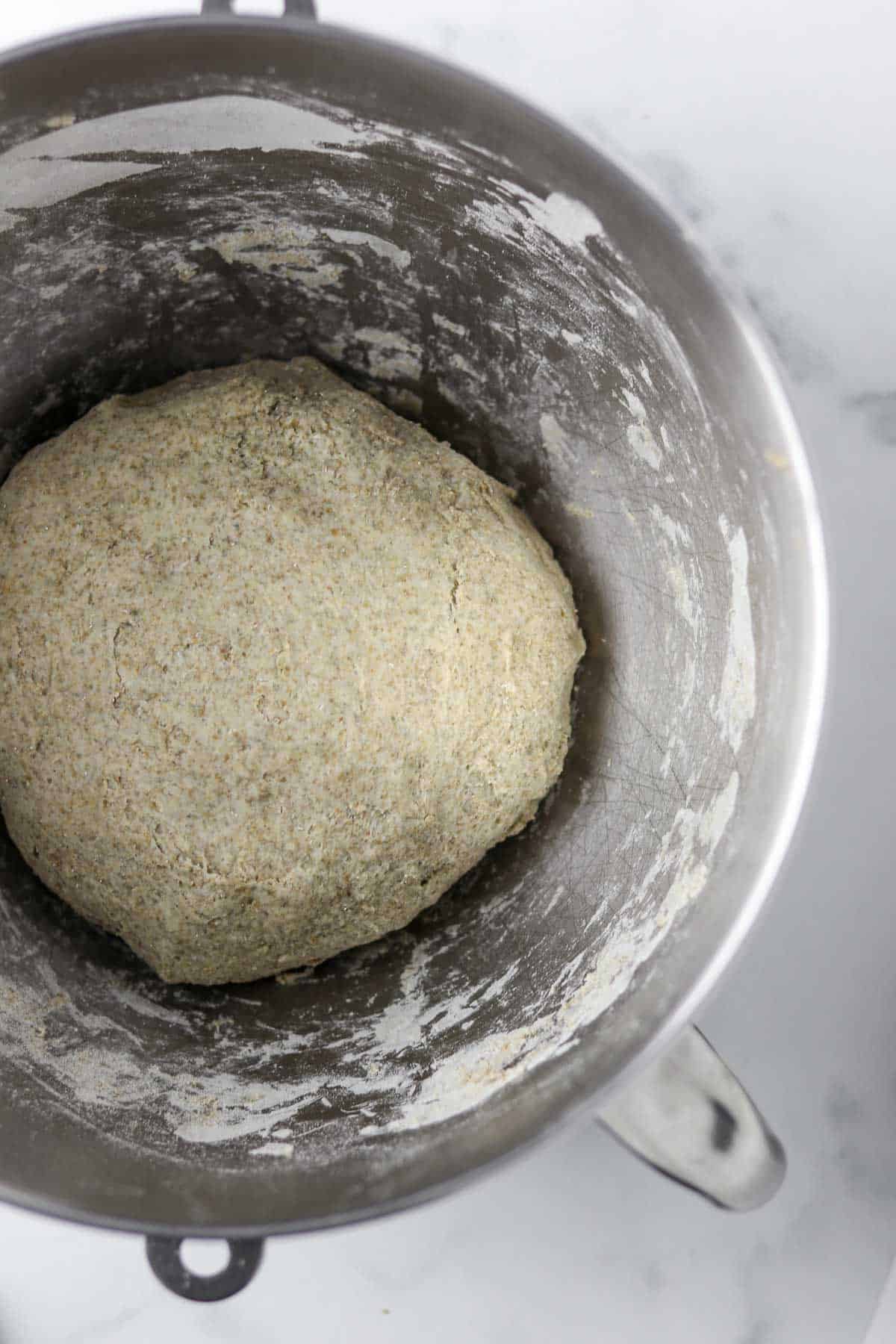
- Step 1: 8-12 hours before you plan to make the bread, combine the rye flour, bread flour, instant yeast and cold water together in a large bowl (I just use the bowl that goes with my stand mixer since that is where it will eventually go....one less bowl to wash). Hold back on the molasses and salt for now. Stir to combine as best you can (mixture will be thick), and then knead briefly with your hands until you have a cohesive mixture. The dough will be very thick and clay-like in texture. Cover with plastic wrap and set aside at room temperature.
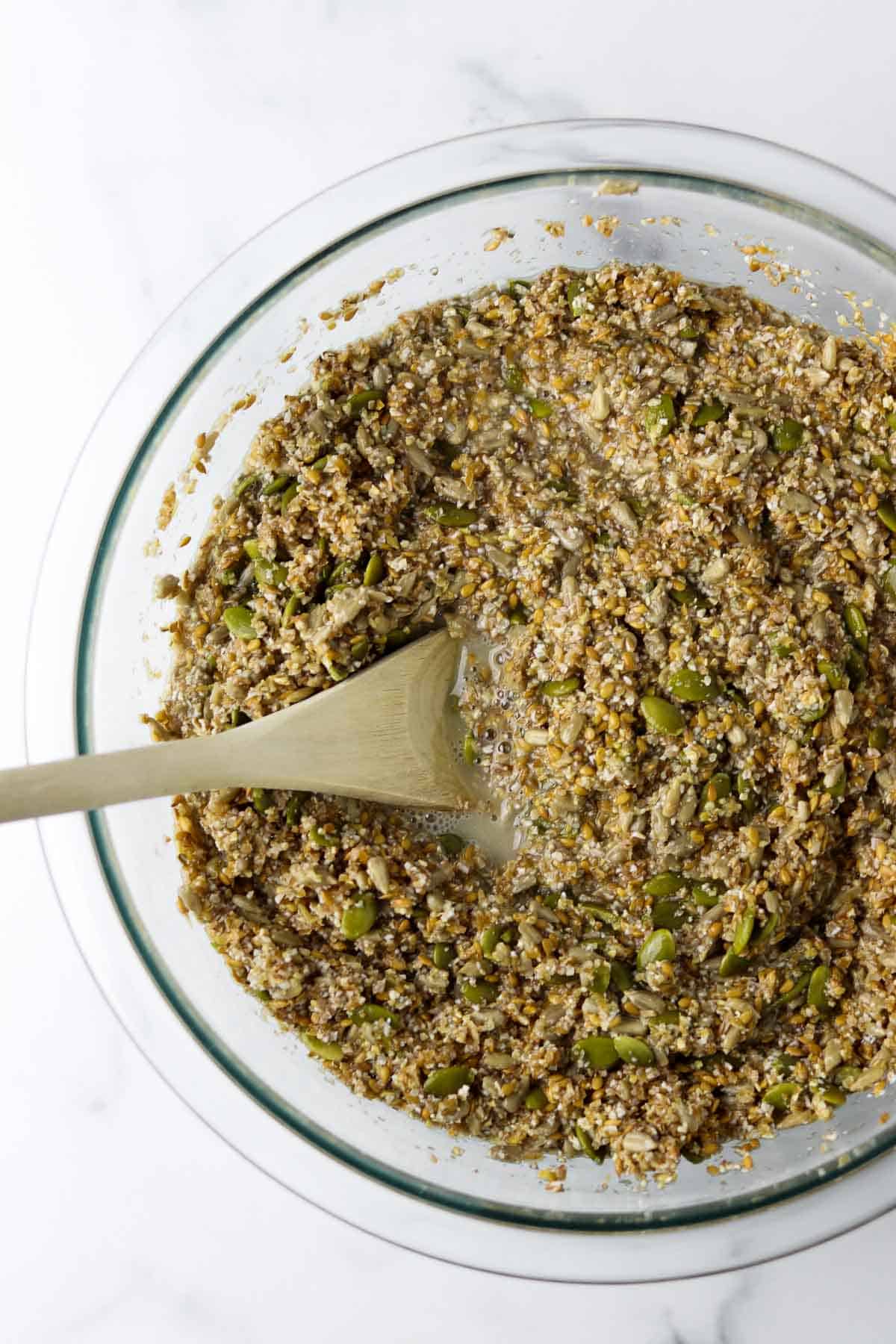
- Step 2: At the same time, mix the soaker together: Combine all the ingredients for the soaker together in a medium bowl. Cover with plastic wrap and set aside at room temperature.
The Morning of Baking:

- Step 3: 8-12 hours later, finish mixing the dough: Grease a 13 x 4 inch pullman loaf pan with butter and dust with rye flour, including the lid. Set aside. Combine the dough, molasses, salt and the soaker (do not drain the soaker. Go ahead and put in the water and the soaked seeds) in the work bowl of a stand mixer. Using the paddle attachment, mix on low for 2-3 minutes, scraping down the sides occasionally. Increase the speed to medium and continue to mix for another 2-3 minutes. The dough will be very sticky at this point.
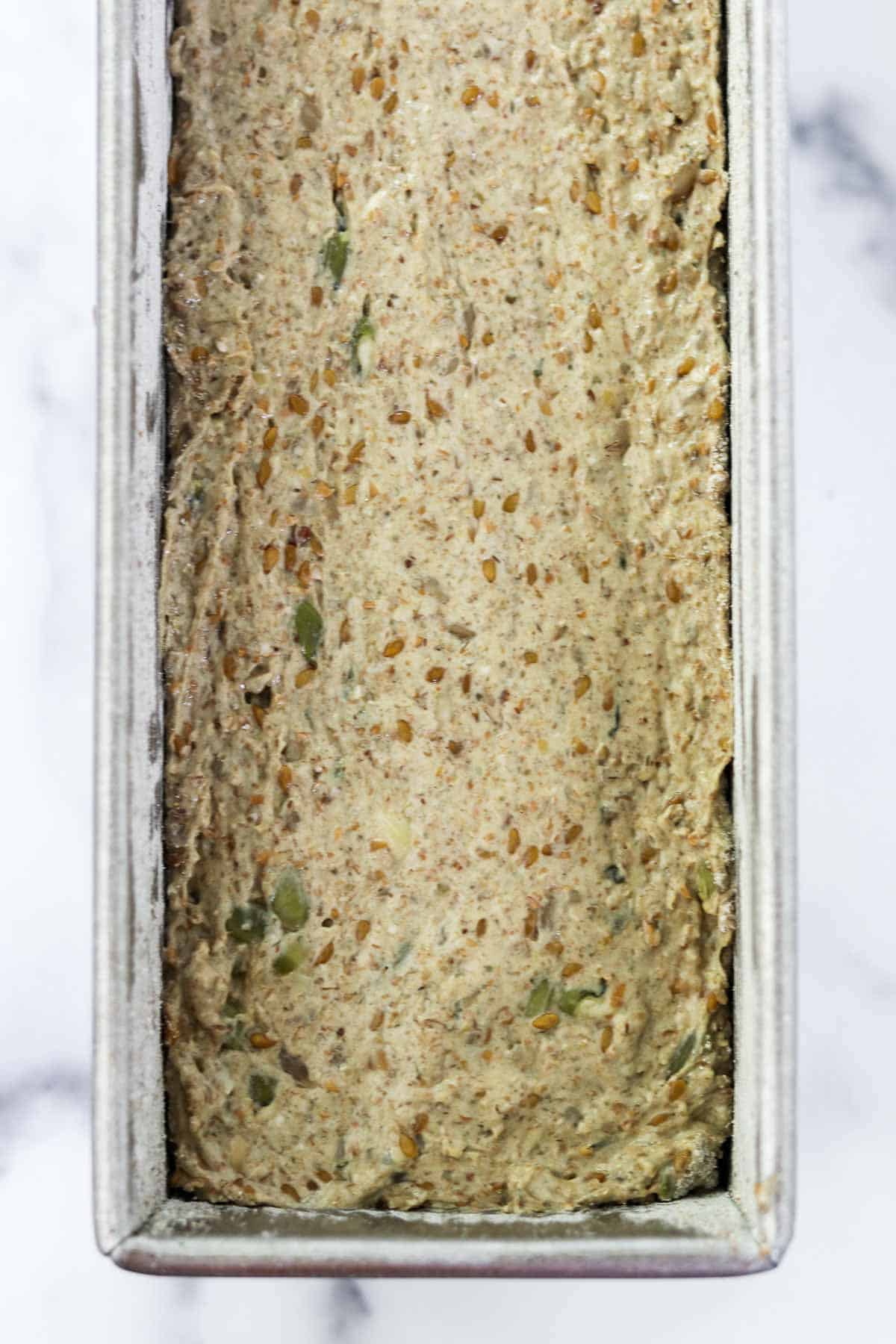
- Step 4: Scrape or spoon the dough into the prepared pan and smooth out the top. Damp fingers or a moistened spatula can help with this if you are having a hard time getting the top smooth.
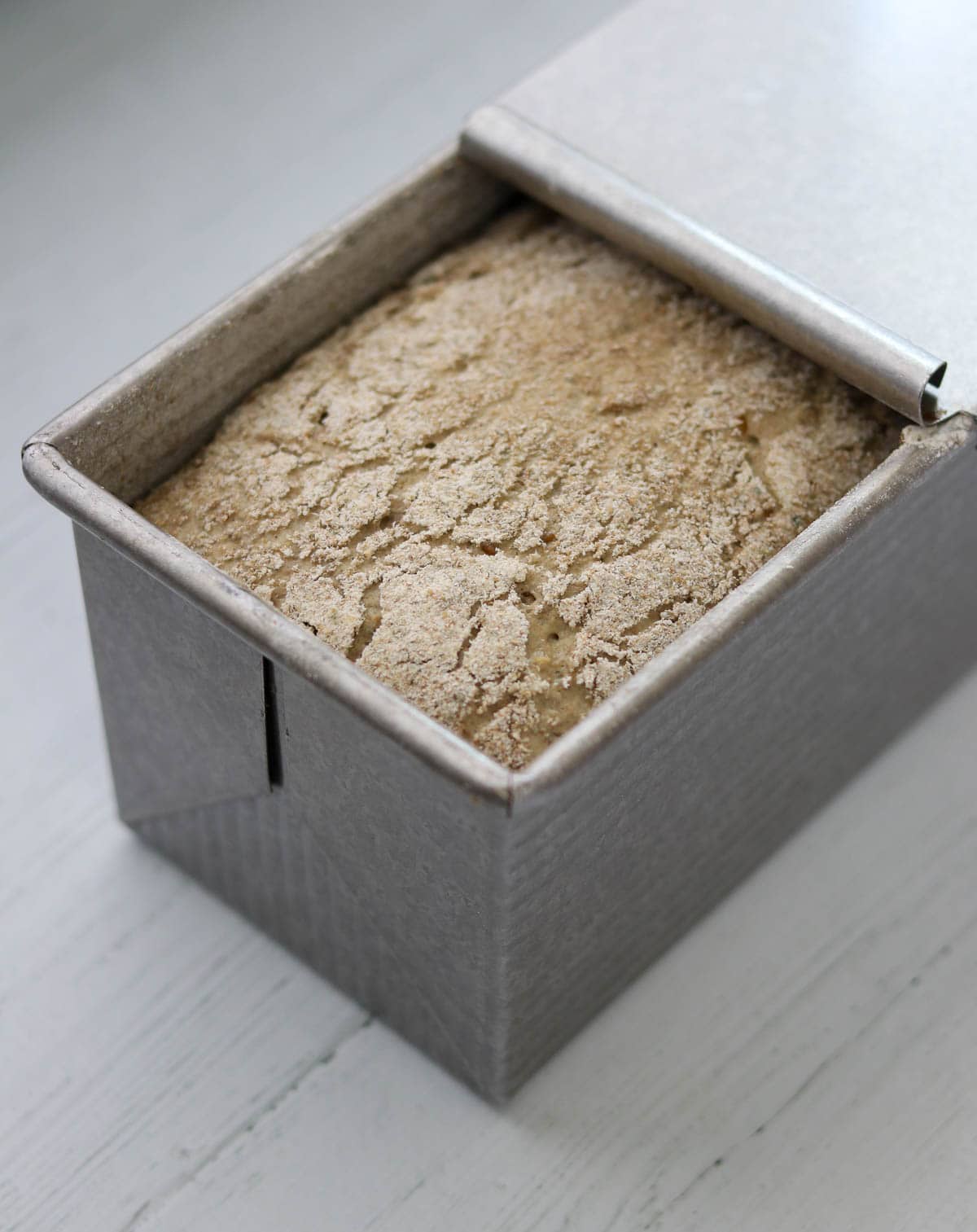
- Step 5: Dust the top of the loaf with a thin, even layer of rye flour and place the pullman lid cover on top of the pan. Let the dough rise for 1½ -3 hours at room temperature or until it is about ½ inch from the top of the pan. The time that it takes for your dough to rise will largely depend on the temperature of the dough and your kitchen.
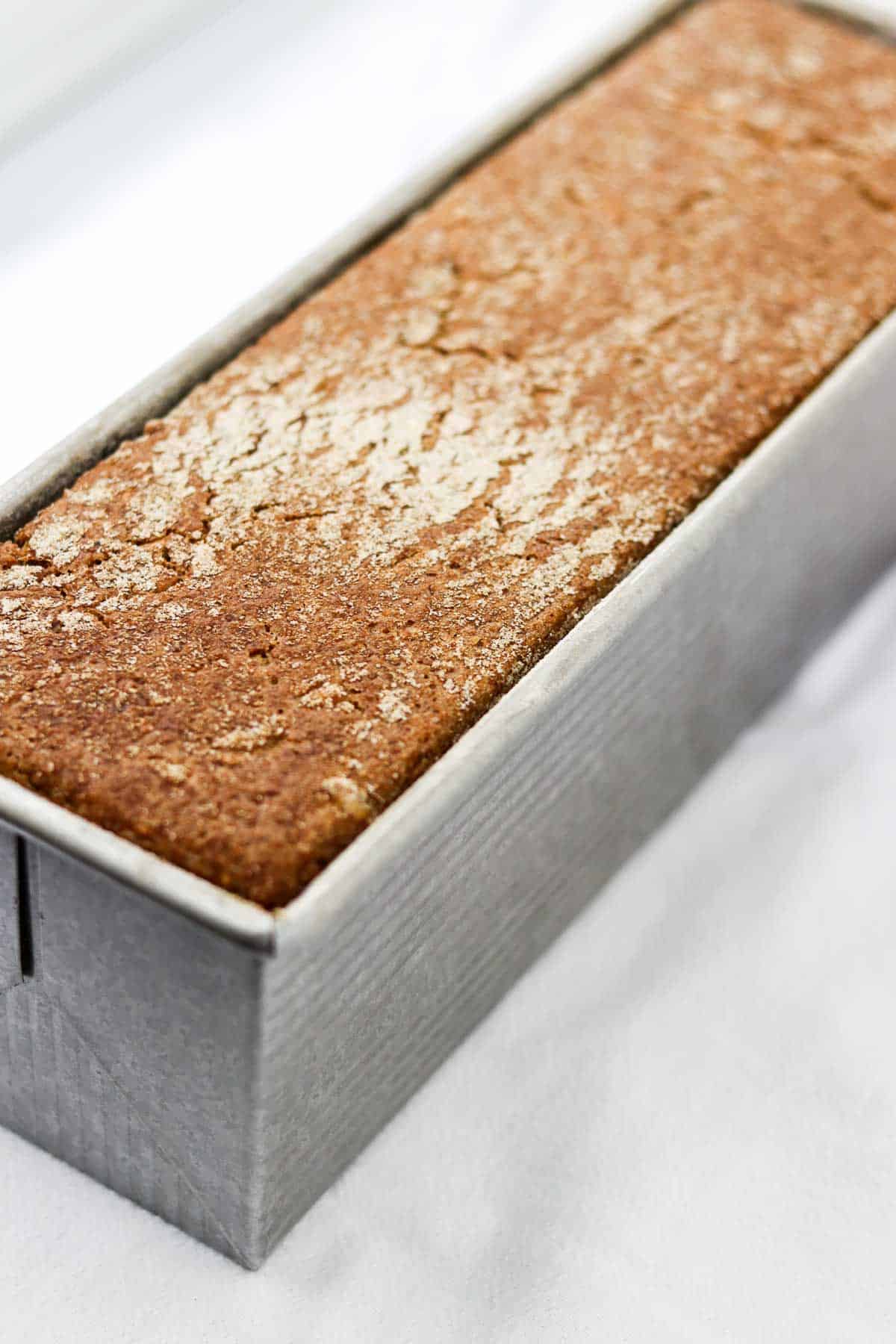
- Step 6: Meanwhile, preheat the oven to 500 degrees. Bake the loaf with the lid on for 15 minutes. Reduce the temperature to 400 degrees and continue to bake, covered, for an additional 15 minutes. Remove the pan from oven and carefully slide the lid off. Reduce the temperature to 325 degrees and bake, uncovered, for an additional 45 minutes.

- Step 7: Remove from the oven and immediately turn the loaf out onto a metal cooling rack set inside a rimmed baking sheet. Return the bread to the oven for an additional 10 minutes. Remove from the oven and allow the bread to cool completely before slicing, at least 3 hours or overnight if you can wait! Rye bread is even better a day after baking.
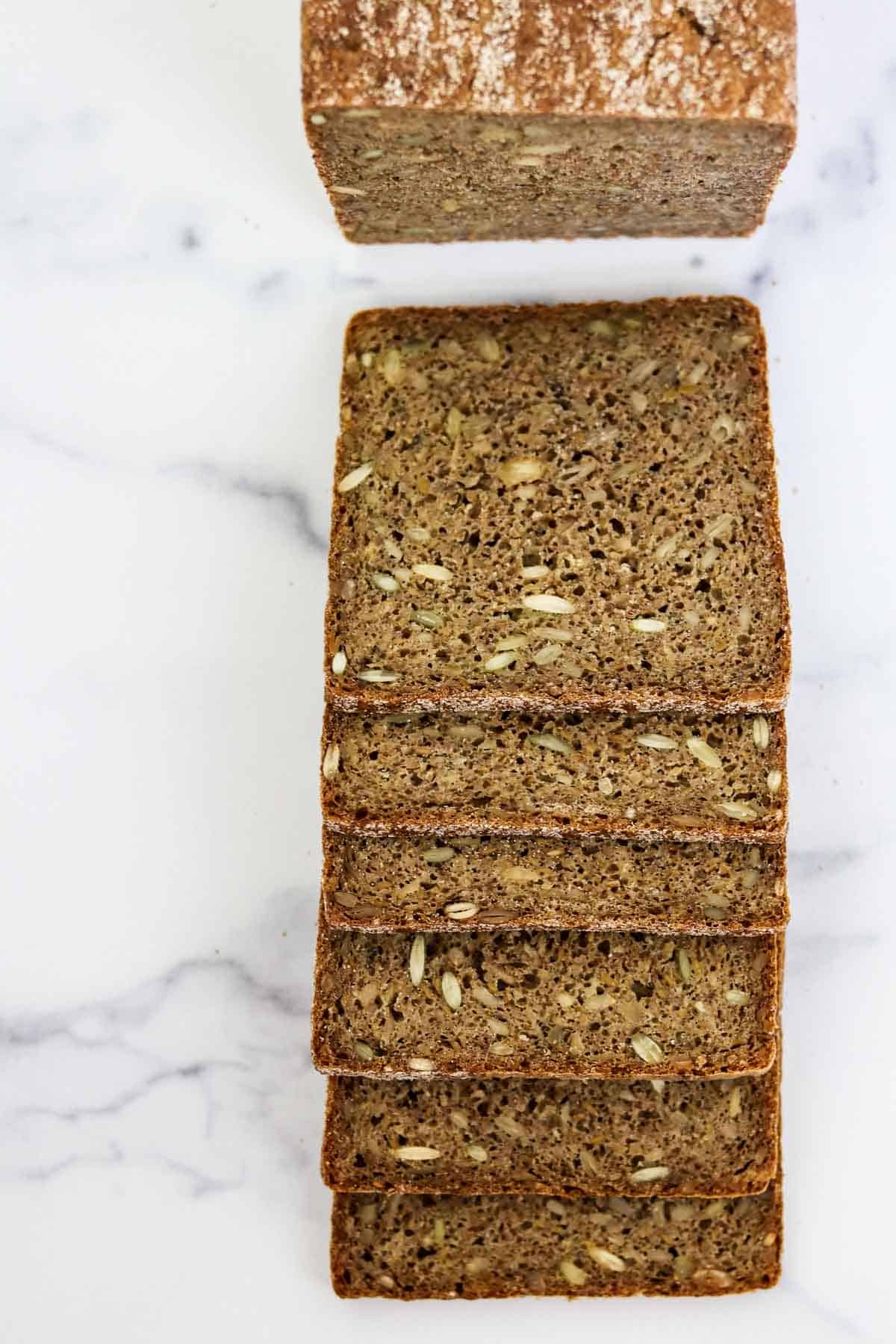
- Step 8: Remove from the oven and allow the bread to cool completely before slicing, at least 3 hours or overnight if you can wait! Rye bread is even better a day after baking.
Expert Tip
- Wait a day before enjoying your bread! Unlike wheat breads which are best eaten shortly after cooling, both the texture and flavor of rye bread improves after a rest of 12-24 hours. Once the bread has cooled completely, wrap it loosely in foil and cut into it the following day.
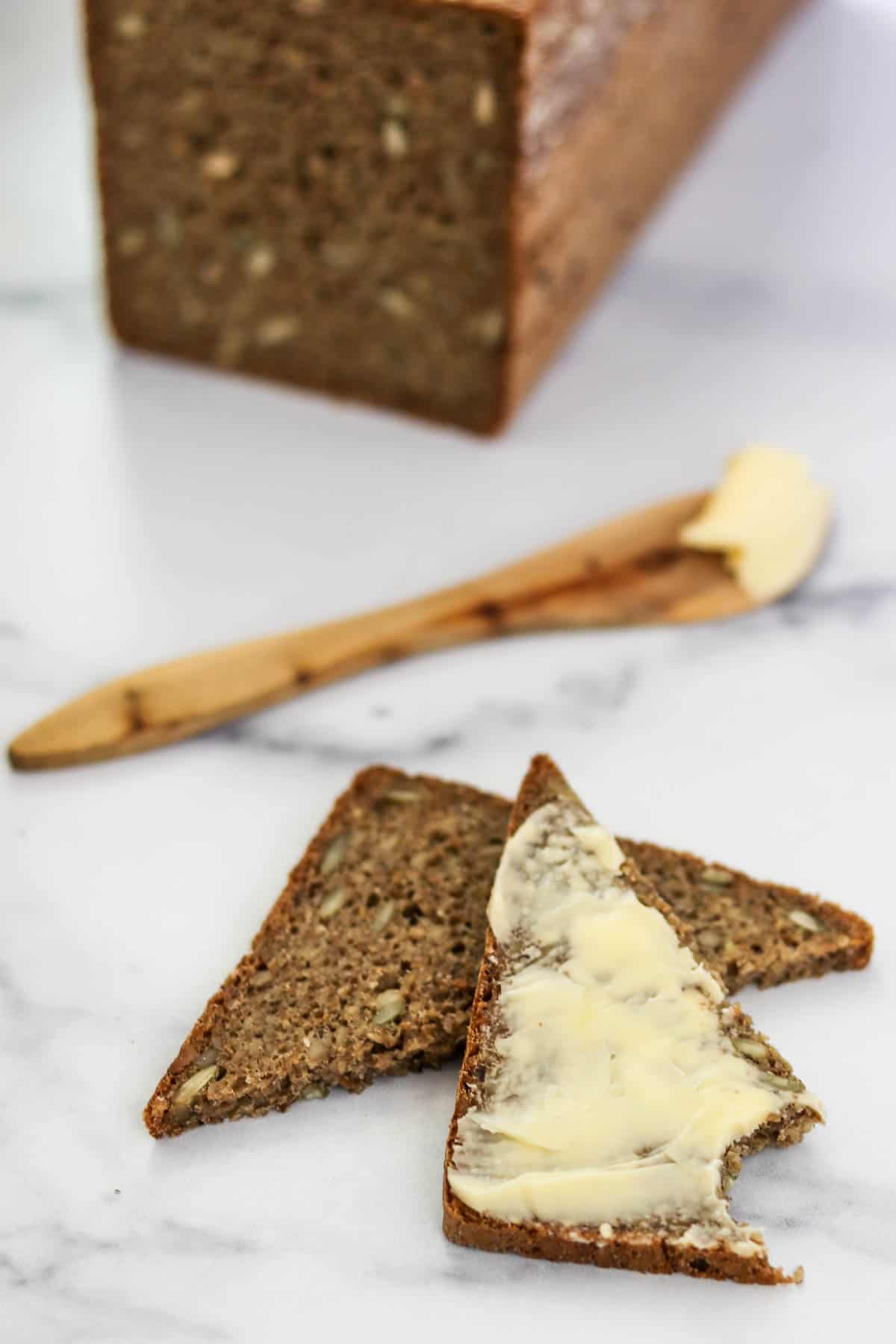
Recipe FAQs
Rugbrød simply means "rye bread" in Danish. It is a sturdy, dense loaf that is comprised of rye flour, chopped rye grains and is often studded with sunflower, pumpkin and/or flax seeds. It is often baked in a 13 x 4 inch pullman pan with a lid. This helps the rye bread bake properly and gives it its characteristic square shape.
It can be stored loosely wrapped in foil at room temperature for about 5 days.
Yes! Rugbrød freezes very well. Tightly wrap the bread (either a whole or partial loaf or slices) in plastic wrap and then either tightly wrap it in foil or place it inside of a freezer bag. It will keep for a couple of months.
I have had many readers tell me they have split the dough into two 9 x 5 loaf pans instead of using the pullman pan with excellent results. Use a heavy baking sheet as a "lid" for the covered portion of the baking and keep the baking times and temperatures the same.
If you have a smaller mixer, it may be difficult to get all of the dough in the bowl at one time. If that is the case, simply mix half of the overnight dough, molasses, salt and the soaker and then mix the second half. Combine all of the dough together in the loaf pan for baking.
Rye breads, particularly those baked here in America, often have a variety of ingredients added to them to enhance their color (making them darker in appearance) and flavor. Common additions include caramel coloring (no thank you), stout beer, cocoa powder, espresso powder and molasses. Rugbrød, in contrast, has very little additional flavoring, perhaps just a little molasses for sweetening. It is meant to be a very straightforward bread so that it can serve as a neutral base for a variety of different sandwich toppings.
Sometimes I will come across a rugbrød recipe that calls for flavor enhancers such as caraway, fennel or anise seed in the dough, but this seems to be more of an exception than the rule.
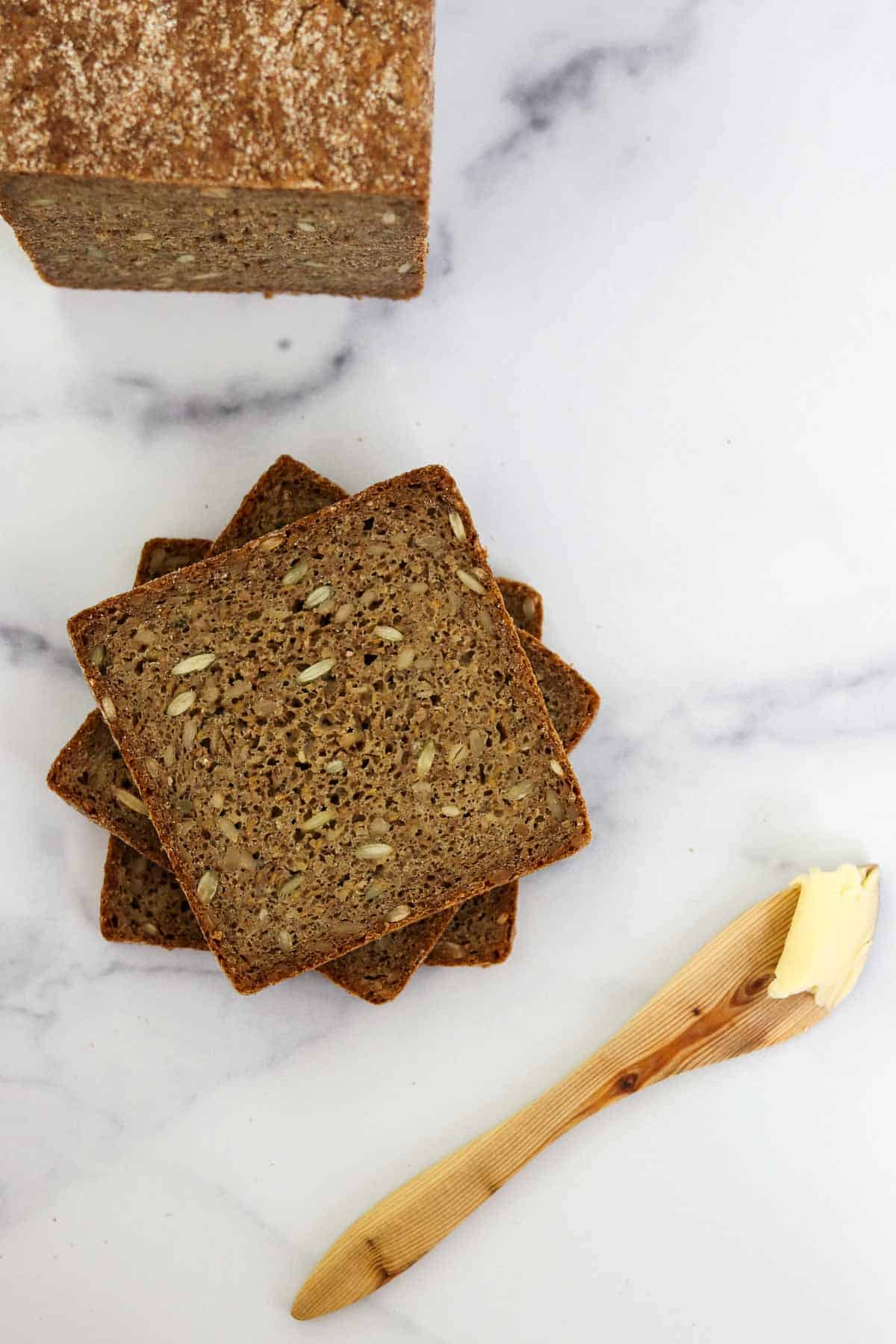
How and What to serve with Rugbrød
When it is served, Rugbrød is typically sliced thin (a little less than a quarter of an inch) and buttered liberally with salted butter. There is actually a word in Danish, tandsmør, which means "tooth butter". It refers to buttering your bread generously enough so that when you bite into it you can see your teeth marks in it.
It may be enjoyed as is, simply slathered with butter, or it can be piled with additional ingredients to form the base of smørrebrød , the famous Danish open-faced sandwiches. Check out this post about How to Make Smørrebrød at Home for everything you need to know about making these deliciously beautiful open-faced sandwiches with your rugbrød!
Related Recipes
Looking for more Scandinavian rye bread recipes? Give these a try:
If you tried this Danish Rye Bread (Rugbrød) recipe or any other recipe on my website, please leave a 🌟 star rating and let me know how it goes in the comments below. I love hearing from you!
Recipe
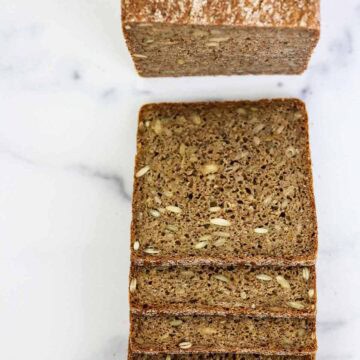
Easy Overnight Danish Rye Bread (Rugbrød)
Ingredients
For the Soaker:
- 2 ½ cups 7 grain hot cereal mix such as Bob’s Red Mill brand or rye chops see note below
- 1 cup raw sunflower seeds
- 1 cup raw pumpkin seeds (pepitas)
- ½ cup flax seeds
- 2 ⅔ cups cold water
For the Dough:
- 2 cups dark rye flour I use the Bob’s Red Mill brand, plus more for dusting the pan and loaf
- 2 cups bread flour
- 1 teaspoon instant dried yeast
- 1 ½ cups cold water
- 4 teaspoons salt
- ¼ cup molasses
- Butter for greasing the pan
Special Equipment Needed:
Instructions
- For the Soaker: Combine all the ingredients for the soaker in a medium bowl. Cover with plastic wrap and let sit at room temperature overnight, approximately 8-12 hours.
- For the Dough: Combine both flours, yeast and water in a separate bowl. Stir to combine as best you can (mixture will be thick), and then knead briefly with your hands until you have a cohesive mixture. Dough will be very thick and clay-like in texture. Cover with plastic wrap and let sit at room temperature overnight, about 8-12 hours.
- Grease a 13 x 4 inch pullman pan with lid with butter and dust with rye flour, including the lid. Set aside. Combine the soaker, flour mixture, salt and molasses in the bowl of a stand mixer. Fit mixer with paddle attachment and mix on low speed for 2-3 minutes until everything is thoroughly combined, scraping down the sides of the bowl from time to time. Increase speed to medium and mix for an additional 2-3 minutes, stopping to occasionally scrape down the sides of the bowl. Mixture will be quite sticky.
- Transfer the dough to the prepared pan. Smooth out the top and sift a thin layer of rye flour over the surface of the dough. Place lid on pan and let the dough rise for 1½ -3 hours at room temperature or until it is about ½ inch from the top of the pan. The time that it takes for your dough to rise will largely depend on the temperature of the dough and your kitchen.
- Meanwhile, preheat the oven to 500 degrees. Bake the loaf with the lid on for 15 minutes. Reduce the temperature to 400 degrees and continue to bake, covered, for an additional 15 minutes. Remove the pan from oven and carefully slide the lid off. Reduce the temperature to 325 degrees and bake, uncovered, for an additional 45 minutes. Remove from the oven and immediately turn the loaf out onto a metal cooling rack set inside a rimmed baking sheet. Return the bread to the oven for an additional 10 minutes. Remove from the oven and allow the bread to cool completely before slicing, at least 3 hours. Rye bread is even better a day after baking. If you can wait until the following day, let the completely cooled bread sit at room temperature loosely wrapped in foil overnight before slicing. The bread will keep at room temperature for 3-5 days loosely wrapped in foil. Freeze for longer storage.

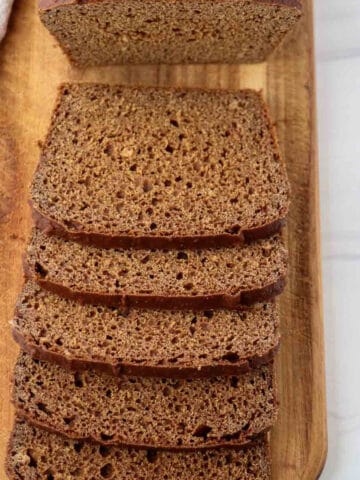

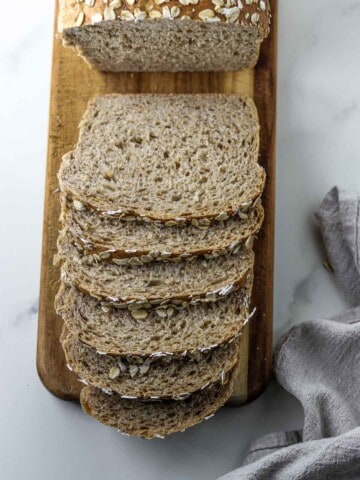
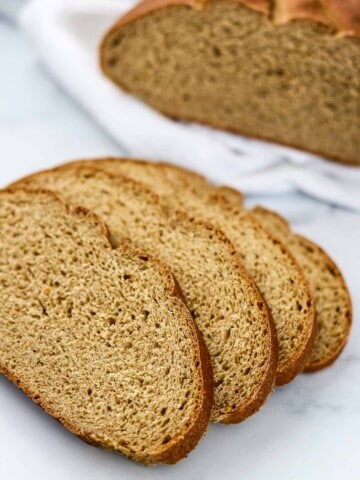

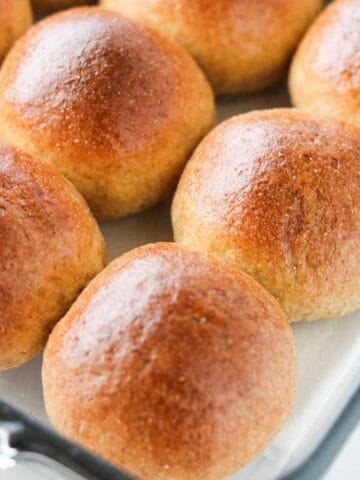

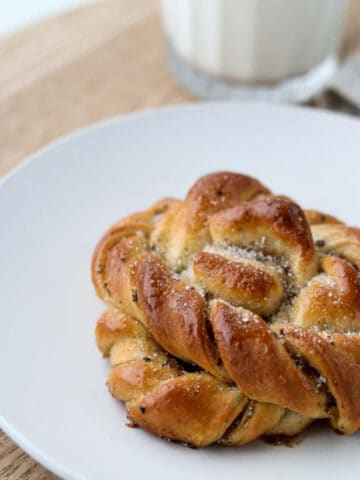
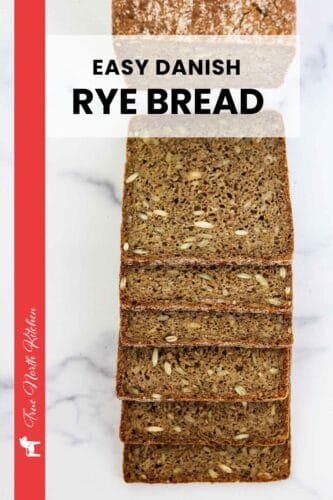
Erin says
This bread is worth the price and storage of a Pullman pan. I make it regularly and freeze slices that we toast for breakfast or to have with soup.
Janis says
Hi!
I just got back from Scandinavia (for the second time) and already miss this bread! I am wondering, do you think this recipe would work in a bread machine? (Novice baker here....and lazy baker. Lol).
Thank you in advance!
Kristi says
Hi Janis,
This bread probably won't work in a bread machine because the dough is super sticky and not much like a regular bread dough at all. I would still encourage you to try it without the bread machine! It really is easy and fabulous. If you want something more bread machine friendly, try my Swedish Limpa bread. Or another easy one would the Kavring bread which relies on baking powder rather than yeast as a leavener. Lots of yummy options.
Happy Baking!
Kristi
Meghan says
Do you need the pullman pan for this recipe? I don't have one and can't find one to buy locally. I'd have to order online, which would take too long (I want to start this recipe tonight!) Would regular 9x5 loaf pans work if I divided the dough between them?
Kristi says
Yes, that works! Just split the dough between two regular sized bread pans or make a half recipe for one. Use a she pan or something similar as a lid during the covered baking. Baking time is the same.
Kimfusion says
I've not tried this yet, but I have the soaker and dough doing their thing for the next 12 hours.
My question is: 4 teaspoons of salt seems excessive. Is that really how much salt this recipe calls for and does it not overpower the bread with saltiness?
Kristi says
Hello,
It is a huge loaf of bread so it definitely won't be salty. If you are uncomfortable with that amount, you could always reduce it by a teaspoon. I wouldn't do much more than that. Please let me know how it turns out!
Kristi
RPG says
This bread is really so delicious! I’ve been making it for about 6 months & usually cut the whole bread into thirds to share with friends, which makes me a superhero. Today, I returned to the recipe for another batch & noticed that the metric measurements have been replaced with US. Any chance you might add those back into the recipe for those of us using a scale in the kitchen? Thank you!
Kristi says
Hello!
Thanks so much for your comment. I actually just updated that recipe and the metric measurements are still there but you need to scroll down past the "Special Equipment Needed" section and you will find a link for "US Customary" (this is the default) and "Metric". Simply click the "Metric" link and it will switch over for you. Hope this helps!
Kristi
Dusty says
After my last trip to Denmark I was determined to make my own Rugbrød. I've had this recipe bookmarked for a while and finally collected everything I needed to give it a go.
If I don't say so myself, it's just as good as the finest Rugbrød I had in Denmark, and certainly better than any I bought from a supermarket! Thank you so much for posting it! What a fantastic recipe!
P.s Only when I started did I notice I was out of flaxseed, which I replaced successfully with quinoa. Excited to be more playful with my grain combinations in the future.
Kristi says
Hi Dusty,
Thanks so much for your review! I'm glad you enjoyed the bread and I love that you substituted quinoa here. Genius!
Kristi
Kristy Friisdahl says
Hey Kristi, have you made this recipe with Rye Chops previously? That is the only difference between your recipe and mine, and somehow both times when I've combined the overnight dough, salt and mollasses) and overnight soak, when I mix it, it separates all the gluten strands and becomes like a soupy mess. Thank you.
Kristi says
Hi Kristy,
Thanks for your question! I have used rye chops but it's been awhile. I usually use the 7 grain cereal. Did you try baking the loaf despite the soupy mess appearance of the dough?
Kristi
Monica says
Great recipe that I make often for my daily bread.
Since I am a lazy baker, i mixed everything together in one bowl and followed the directions for the first rise, then put the dough into the Pullman pan for the second rise and bake. It always turns out fantastic.
Like others have written, this recipe is one I’ve scoured the internet for. Thank you for sharing it!
Anna says
Thank you so much for this easy recipe! I have been looking for a recipe to recreate the delicious bread we had in Denmark a couple of years ago, and the other recipes I tried were either way too complicated or didn’t taste close. I made this today and am very pleased with the results. I don’t have a Pullman pan but split the dough between two regular loaf pans and didn't cover them. Although they domed a bit, the bread has the right texture and excellent flavor. Keeper recipe!
Kristi says
Thanks, Anna!
Rob says
Thank you for this! It is very clear and well written and it turned out great for me, a very beginning bread baker. I have been unsuccessfully looking for something like rugbrød in stores ever since we left Denmark 31 years ago so it is great to finally be able to make our own. We have had to settle on the occasional visit to Denmark or a rare Danish bakery in the US.
The outer crust is nicely crisp and the inside is soft. It holds together well when sliced.
Kristi says
Thanks for your feedback, Rob! I'm so glad you liked it!
Kristi
Janet Kylstad Coulon says
First off, thank you for all of the detailed pictures, text, and video. You put a lot of work into this!! But somehow I still managed to end up having questions. 🙂 I've tried to make this style of bread before (other recipes) and your recipe was the only one that finally worked for me, even though right as I was about to put it in the oven, I was unexpectedly called away for the day. I put the pan in the fridge, but it still rose and oozed out of the lid. I baked it anyway but then had to pry off the lid and the top was ruined a bit. Even with all that, the majority of the loaf was fine. Mostly.
Because I'm not really familiar with how this bread is supposed to be, I'm questioning if mine was baked long enough. I used an oven thermometer, so I think the temp was right the whole time. But I felt it was a wee bit too "wet" in places. Do you think this bread would be done at 190-200 degrees like other breads? I didn't take its temperature. But maybe it's supposed to be moist like that? It was a coldish rainy day when I made it. So I'm wondering if I added too much water in the beginning?
I'm going to try it again and hopefully will be able to stay home all day. How do you know for sure that it's done at the end?
Kristi says
Hi Janet,
Thanks for your question! Definitely try it again when you won't be interrupted. The temp should be between 200 and 210 F. Please report back and let me know how it goes!
Kristi
Ulrike says
I had the same problem first time around and started to take off some of the dough ( about 80 to 100 Gram ) . Also checked the level of rise after 2 hours and waited 30 min longer to make sure this is just about the same measurement in the recipe given . I used the leftover dough to make 3 Rolls - small bread pan covered with foil . Added to oven for 500 and 400 and gave 10 min at 335 - done ! Worked out great . I had no 7 grain used 10 grain and it’s perfect . Cut into 26 slices with bread slicer and made 4 slice packets for the freezer . Hope this helps 🙂
Sharon Borgford says
Your recipe is well-written and easy to follow, and I was delighted to find it. Suggestion: For even veteran bakers like me, however, I would have liked your cautioning that the soaker and dough BOTH rest during the same 8-12 hour period, as I assumed (incorrectly) that the rest of the ingredients were added to the soaker the next day, with the first rising following directly afterwards. This morning I have a soaker ready to use, but dough that isn't: I missed the crucial details noted on the back of my printed copy of the recipe. I've placed the soaker in the refrigerator for use tomorrow morning and am hoping that works out OK.
Kristi says
Hi Sharon,
Sorry for the confusion! You are absolutely right.....the soaker will be fine overnight. I will take a look at the wording of the recipe and see how I can clarify. Thanks for the comment!
Kristi
Ashley Andreasen says
Yum!! Deceptively easy and made the best roast beef smorbrod!! Everyone was raving about how delicious the bread was!
Kristi says
Thanks, Ashley!
Al DiScenna says
Your recipe is easy to follow and it results in a delicious and hearty rye loaf!
Kristi says
Thank you for the comment! I'm so glad you enjoyed the bread!
Kristi